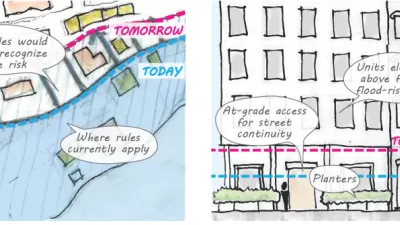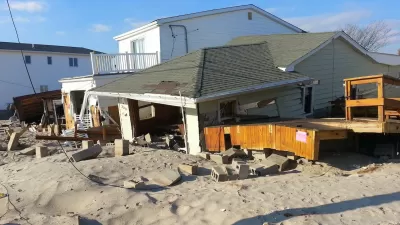Only a few places have managed to stem the tide of development in areas at risk to the effects (like wildfire and flooding) of climate change. Virginia Beach is an early test bed for what it takes to tell developers "no."

Christopher Flavelle and John Schwartz report from Virginia Beach, where the city recently became a leader in climate-aware development restrictions—i.e., saying no to developers proposing buildings on land at risk of flooding from sea-level rise and extreme weather.
The city last year became one of a small but growing number of communities willing to say no to developers — despite their political and economic clout — when it rejected a proposal to build a few dozen homes on this soggy parcel of 50 acres, arguing that those homes would be unsafe. The developers sued, accusing officials of making their project a scapegoat as voters clamored for action after disastrous flooding.
This past May, a judge ruled that Virginia Beach was within its rights to stop the development. The city’s experience could become a harbinger for others nationwide.
According to the article, the confrontation between Virginia Beach and this developer is emblematic of many future, similar conflicts, the outcomes of which will determine the vulnerability of Americans to climate change in the future. The recent track record of this conflict has favored developers and introduced risk to many communities:
In many coastal states, homes are going up at the fastest rate in the most flood-prone areas. The number of new houses in what experts call the wildland-urban interface, where the wildfire threat tends to be greatest, increased 41 percent nationwide between 1990 and 2010.
A recent report from the Pew Charitable Trusts provides additional background for the this feature-length story. The "Mitigation Matters: Policy Solutions to Reduce Local Flood Risk" report is available online.
FULL STORY: As Climate Risk Grows, Cities Test a Tough Strategy: Saying ‘No’ to Developers

Alabama: Trump Terminates Settlements for Black Communities Harmed By Raw Sewage
Trump deemed the landmark civil rights agreement “illegal DEI and environmental justice policy.”

Planetizen Federal Action Tracker
A weekly monitor of how Trump’s orders and actions are impacting planners and planning in America.

The 120 Year Old Tiny Home Villages That Sheltered San Francisco’s Earthquake Refugees
More than a century ago, San Francisco mobilized to house thousands of residents displaced by the 1906 earthquake. Could their strategy offer a model for the present?

In Both Crashes and Crime, Public Transportation is Far Safer than Driving
Contrary to popular assumptions, public transportation has far lower crash and crime rates than automobile travel. For safer communities, improve and encourage transit travel.

Report: Zoning Reforms Should Complement Nashville’s Ambitious Transit Plan
Without reform, restrictive zoning codes will limit the impact of the city’s planned transit expansion and could exclude some of the residents who depend on transit the most.

Judge Orders Release of Frozen IRA, IIJA Funding
The decision is a victory for environmental groups who charged that freezing funds for critical infrastructure and disaster response programs caused “real and irreparable harm” to communities.
Urban Design for Planners 1: Software Tools
This six-course series explores essential urban design concepts using open source software and equips planners with the tools they need to participate fully in the urban design process.
Planning for Universal Design
Learn the tools for implementing Universal Design in planning regulations.
Clanton & Associates, Inc.
Jessamine County Fiscal Court
Institute for Housing and Urban Development Studies (IHS)
City of Grandview
Harvard GSD Executive Education
Toledo-Lucas County Plan Commissions
Salt Lake City
NYU Wagner Graduate School of Public Service





























